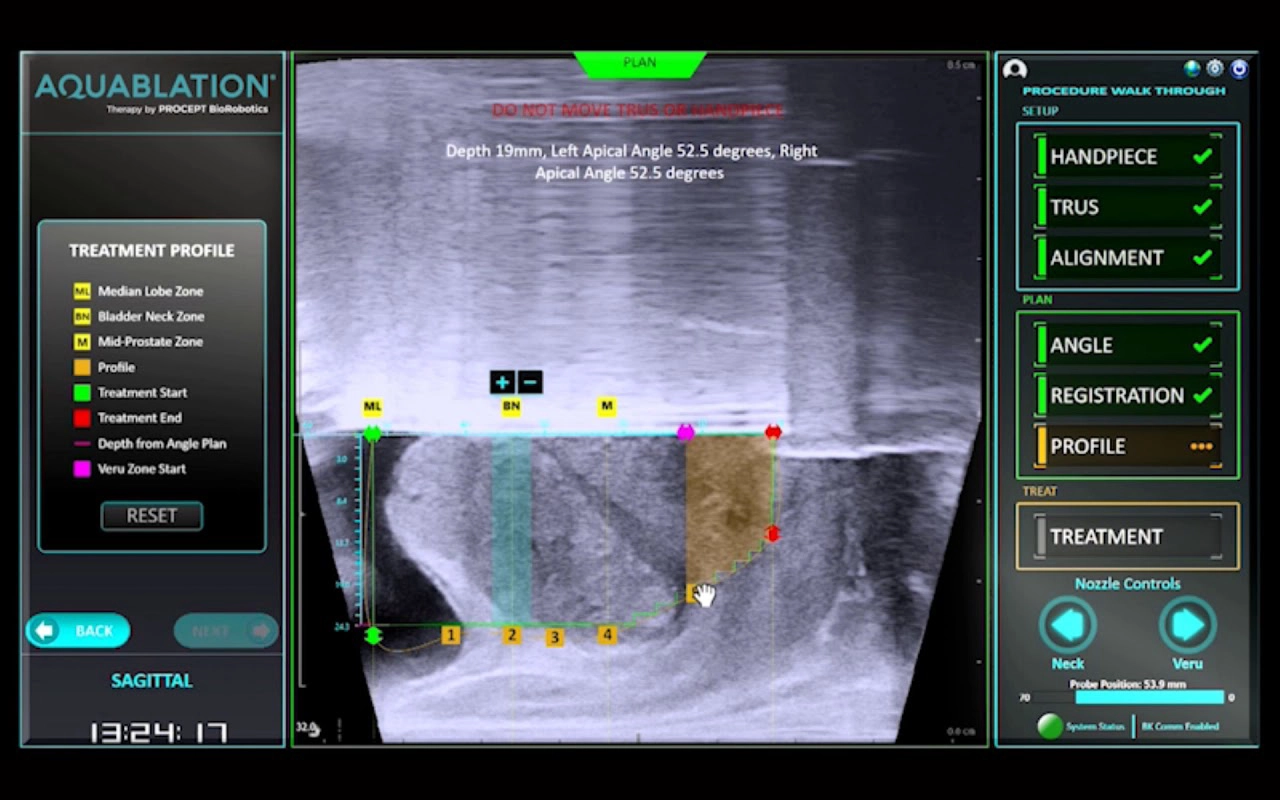Team Spotlight
How does Aquablation Therapy Work?

Aquablation therapy is the only real-time, ultrasound-guided, robotic-assisted, heat-free waterjet for the treatment of benign prostatic hyperplasia (BPH). At Adventist Health Simi Valley, we are proud to offer this advanced, minimally invasive treatment. Using a heat-free waterjet controlled by robotic-assisted technology, this unique therapeutic approach can be performed on prostates of any shape and size to deliver durable, long-lasting relief with low rates of irreversible side effects.
|
83% men with BPH are not willing to sacrifice sexual function for symptom relief with surgery |
3 in 4 men with BPH feel that surgery requires a tradeoff between symptom relief and side effects |
1 in 2 men with BPH did not realize how important maintaining sexual function was to them before surgery4 |
Watch how men have regained quality of life by choosing aquablation therapy for BPH relief.
How does aquablation therapy work?
Aquablation therapy is a resective procedure, which means that the prostate tissue causing symptoms is surgically removed. No incision is made in the abdomen, as the prostate is reached through the urethra.
Aquablation therapy is performed in a hospital. You will be under anesthesia for the entire procedure. The procedure typically takes an hour and may involve an overnight stay.
There are two key steps to the aquablation therapy procedure:
Step 1. Surgical Planning
Every prostate is unique in size and shape. Aquablation therapy enables our specialist Desiree Sanchez, MD to customize your procedure to your specific anatomy.
How? Aquablation therapy is the only BPH surgical procedure that integrates ultrasound imaging with the standard camera (called a cystoscope). With the help of ultrasound imaging, doctors can create a detailed guide to plan the procedure, outlining the specific areas of the prostate that need removal. The tissue within the marked area of the prostate may be removed, while the tissue outside of it may remain untouched. This real-time visualization allows Dr. Sanchez to map which parts of your prostate to remove and which parts to avoid, specifically enabling her to avoid removing areas that could cause irreversible complications like erectile dysfunction, ejaculatory dysfunction, and incontinence.
Step 2. Prostate Tissue Removal
Once a surgical map is created, a robotic-assisted system follows the surgical plan and resects the targeted prostate tissue using a heat-free waterjet. This advanced technology helps ensure precise, consistent, and predictable removal of the tissue. When required, a minimal amount of cautery may be used following an aquablation procedure to control bleeding.
What are the side effects of aquablation therapy?
We know that the primary reason men are delaying surgery is because they are concerned about side effects. In fact, a recent survey shows that 85% of men are concerned that surgery will cause incontinence, and 4 out of 5 men are concerned that surgery will have a permanent impact on their sexual function.
In clinical studies, men who had aquablation therapy had a very low rate of irreversible complications, such as incontinence, ejaculatory dysfunction, erectile dysfunction.
|
100% of patients had no impact on erectile function, orgasmic function, sexual desire, intercourse satisfaction, or overall sexual satisfaction |
89% men with BPH preserve ejaculatory function with aquablation therapy |
>99% men with BPH did not have incontinence after aquablation therapy |
Is aquablation therapy right for you?
Aquablation therapy is a different kind of surgical procedure. There are many reasons it may be right for you, but make sure to discuss with Dr. Sanchez to see if you’re a candidate.
Aquablation therapy recovery
As with most benign prostatic hyperplasia procedures, you will wake up with a catheter following Aquablation therapy, which allows you to urinate while your urethra heals. The procedure may involve an overnight stay in the hospital. The benefit with Aquablation therapy is that most patients end up leaving the hospital without a catheter.
Once you’re home, you may notice for several weeks a mild burning sensation and urinary urgency, a sudden and intense need to urinate that is difficult to hold off. This can be managed with mild pain medication. Patients can resume their normal activities once approved by their doctor.
Have questions or want more information?
For more information or to make an appointment, call us at 805-577-8460 to begin the next step toward relief of your BPH symptoms.

